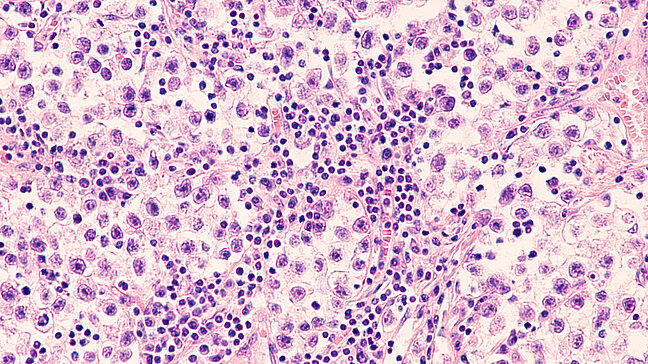
Penile carcinoma
Causes of penile carcinoma
The exact causes of penile carcinoma are not yet fully understood, but certain risk factors increase the likelihood of developing this type of cancer. The most important include infections and chronic inflammations, which can cause long-term changes in the cells. Certain lifestyle factors also play a role.
- **Human Papillomavirus (HPV)**: An infection with HPV, especially high-risk types, is one of the most important risk factors for the development of penile cancer.
- **Phimosis**: A narrowing of the foreskin that makes retraction difficult and impairs hygiene can increase the risk of penile cancer.
- **Chronic Inflammations**: Prolonged inflammations or infections in the genital area can promote the development of cancer cells.
- **Smoking**: Tobacco use is another risk factor, as it weakens the defenses against HPV and increases the risk of penile cancer.
- **Poor Hygiene**: Inadequate intimate hygiene can lead to the accumulation of smegma (a substance made of dead skin cells and sebum), which can increase the risk of cancer.
Symptoms of penile carcinoma
- Sore or ulcer on the penis that does not heal
- Thickening or hardening of the skin on the penis
- Itching or burning
- Bleeding or discharge under the foreskin
- Pain in the area of the penis
- Swelling in the groin area
Diagnosis of penile carcinoma
The diagnosis of penile cancer is made through a combination of physical examination and various diagnostic procedures. A biopsy of the suspicious tissue is the standard test to determine if it is cancer. If there is suspicion of tumor spread, imaging techniques such as ultrasound, MRI, or CT can be performed to determine the extent of the cancer.
Treatment options for penile cancer
The treatment options for penile cancer depend significantly on the stage of the cancer, its spread, and the patient's overall health condition. In early stages, minimally invasive treatment may be sufficient, while more radical measures may be necessary in advanced cases. The goal of treatment is to remove the tumor, prevent its spread, and, if possible, preserve the functionality of the penis. Depending on the individual situation, the following options may be considered:
- **Surgical removal**: In most cases, the tumor is surgically removed. Depending on the extent, this may involve a local excision or a partial or total penectomy (partial or complete removal of the penis).
- **Radiation therapy**: In early stages or as an adjunct to surgery, radiation therapy can be used to destroy cancer cells.
- **Chemotherapy**: In advanced stages or when the cancer has spread to other parts of the body, systemic chemotherapy may be required.
- **Laser therapy or cryotherapy**: These procedures can be used in early stages of cancer to remove or destroy tumor tissue.
- **Lymph node removal**: If the cancer has spread to the lymph nodes in the groin, removal of the affected lymph nodes may be necessary.
Preventive measures for penile cancer
To prevent penile cancer, it is recommended to maintain good genital hygiene and to undergo regular medical examinations. The HPV vaccine can help reduce the risk of infection with high-risk HPV types. Men with phimosis should seek medical assistance to minimize the risk of infections and inflammations. Quitting smoking can also reduce the risk.
Common Patient Questions About Penile Cancer
Penile cancer is a rare disease. In Germany, approximately 950 new cases are diagnosed annually.
Risk factors include, among others, infections with human papillomaviruses (HPV), chronic inflammations such as lichen sclerosus, smoking, and poor genital hygiene.
The diagnosis is made through a thorough physical examination, during which changes to the penis are assessed and palpable lymph nodes in the groin are checked. Imaging techniques such as ultrasound or magnetic resonance imaging (MRI) can be used to assess the extent of the tumor. A tissue sample (biopsy) confirms the diagnosis.
The prognosis depends on the stage of the disease. If the tumor is detected and treated early, the chances of recovery are good. In advanced stages with metastases, the prognosis worsens accordingly.
![[Translate to English:]](/fileadmin/_processed_/1/d/csm_UZ-Logo-2024-breit-aK-1500px-white-red_4b49b8d28c.png)


